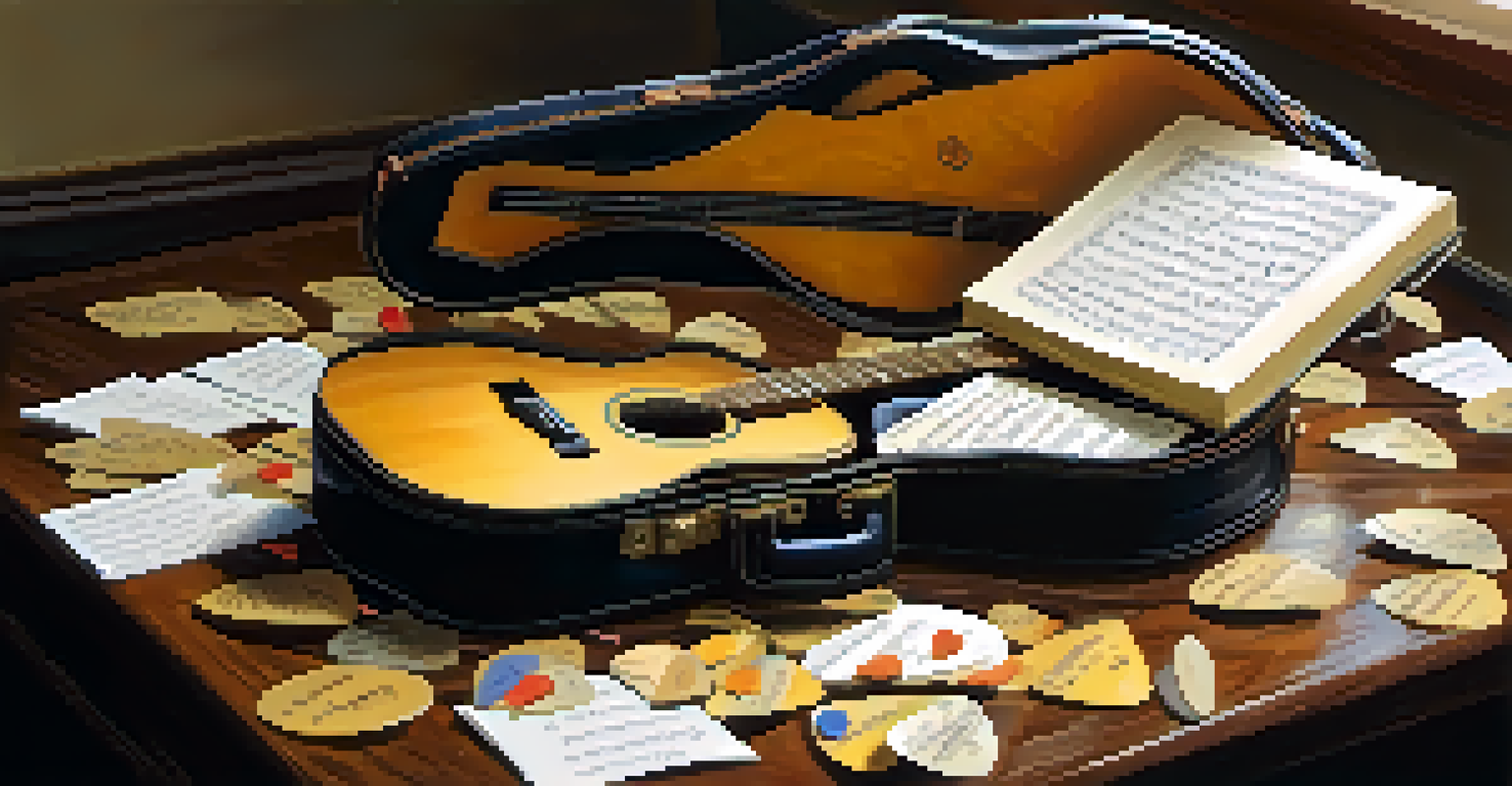Exploring Alternate Tunings: Techniques for Guitar Players

Understanding Alternate Tunings: A New Perspective
Alternate tunings are variations from standard tuning that can unlock new sonic possibilities for guitar players. By changing the pitch of one or more strings, you can create unique sounds and textures that standard tuning may not offer. This fresh approach allows musicians to explore different genres and styles while sparking creativity in songwriting.
Music is the shorthand of emotion.
Many famous guitarists, like Joni Mitchell and Jimmy Page, often used alternate tunings to craft their signature sounds. For example, Mitchell's use of open tunings has given her songs a distinctive character that resonates with listeners. By experimenting with these tunings, you, too, can find your unique voice on the guitar.
Exploring alternate tunings can feel intimidating at first, but the rewards are well worth the effort. As you venture into this territory, you'll discover new chords, melodies, and even a deeper connection with your instrument. Let's dive deeper into some popular tunings and techniques to help you navigate this exciting landscape.
Popular Alternate Tunings: A Brief Overview
There are countless alternate tunings to explore, but some stand out for their versatility and ease of use. One of the most popular is DADGAD, which is often used in folk and Celtic music. This tuning provides a rich, open sound that can inspire beautiful melodies and harmonies.

Another well-known tuning is Open G (DGDGBD), famously used by guitar legends like Keith Richards. This tuning allows for simple chord shapes while producing a full-bodied sound, making it perfect for slide guitar or strumming. By understanding these tunings, you can expand your musical vocabulary significantly.
Unlock Creativity with Alternate Tunings
Exploring alternate tunings allows guitarists to discover unique sounds and enhance their songwriting.
Lastly, consider exploring Open D tuning (DADF#AD), which offers a unique tonal quality that can transform your playing style. Each of these tunings opens doors to different musical expressions, so don't hesitate to experiment with them to find what resonates best with you.
Techniques for Mastering Alternate Tunings
Once you've chosen an alternate tuning, it's essential to develop techniques that complement it. One effective approach is to focus on fingerpicking patterns that highlight the unique chord voicings created by the tuning. This can lead to beautiful and intricate compositions that showcase your creativity.
The guitar is a miniature orchestra in itself.
Another technique is to explore different strumming styles. Experimenting with dynamics—playing softly versus aggressively—can add depth to your performance. By varying your attack on the strings, you can create a wide range of emotions, making your music more compelling.
Lastly, don't forget the importance of ear training. As you play in alternate tunings, listen closely to how the notes interact and harmonize. Developing your ear will help you identify new chord progressions and melodies that could become the foundation of your musical journey.
Incorporating Alternate Tunings into Your Playing
Integrating alternate tunings into your playing can be a transformative experience. Start by selecting a few of your favorite songs and try playing them in a new tuning. This will not only challenge you but also help you discover fresh interpretations of familiar pieces.
As you grow more comfortable with alternate tunings, consider writing original music. The unique sounds produced by these tunings can inspire new melodies and song structures. Embrace the creative process—don't be afraid to explore uncharted territory as you find your musical identity.
Master Techniques for New Sounds
Developing fingerpicking and strumming techniques can help highlight the distinct voicings of alternate tunings.
Also, remember to collaborate with other musicians who are open to using alternate tunings. Playing with others can provide new insights and ideas, enriching your musical experience. Together, you can create something truly special that reflects your collective creativity.
Famous Songs Featuring Alternate Tunings
Many well-known songs utilize alternate tunings to create their signature sound. For instance, 'Black Mountain Side' by Led Zeppelin showcases the beautiful use of DADGAD tuning, allowing for a mesmerizing blend of melody and rhythm. Listening to these songs can provide inspiration and insight into how alternate tunings can be effectively employed.
Another classic example is 'Big Yellow Taxi' by Joni Mitchell, which features an open tuning that enhances the song's emotional impact. By studying these pieces, you can learn how to harness the power of alternate tunings to evoke specific feelings or atmospheres in your own music.
As you explore these famous songs, consider transcribing them in your own style. This exercise not only improves your playing skills but also helps you internalize the techniques used by the original artists. By doing so, you'll develop a deeper understanding of how to incorporate alternate tunings into your repertoire.
Resources for Learning Alternate Tunings
As you embark on your journey into alternate tunings, numerous resources can help guide your learning. Online platforms like YouTube and guitar lesson websites offer tutorials that break down various tunings and techniques. These visual aids can be incredibly beneficial for grasping the concepts and applying them to your playing.
Additionally, consider investing in instructional books or eBooks specifically focused on alternate tunings. Many of these resources provide exercises, song examples, and detailed explanations to help you master the art of tuning your guitar differently. Having a physical or digital reference can keep you motivated and organized in your practice.
Collaborate and Create Together
Working with other musicians using alternate tunings can inspire fresh ideas and enrich your musical journey.
Lastly, don't underestimate the power of community. Join online forums or social media groups dedicated to guitar players exploring alternate tunings. Sharing experiences, tips, and challenges with fellow musicians can be an incredible source of inspiration and support on your musical journey.
Embracing the Journey of Alternate Tunings
Exploring alternate tunings is not just about changing the pitch of your strings; it's about embracing a new mindset as a musician. This journey encourages you to step outside your comfort zone and discover the vast possibilities that await you. With each new tuning, you're opening doors to creativity and self-expression.
As you experiment with different techniques and styles, remember that patience is key. Mastery takes time, and every stumble is an opportunity to learn and grow. Celebrate your progress, and don't rush the process; the joy of discovering new sounds is well worth the journey.

Ultimately, embracing alternate tunings can lead to a deeper connection with your guitar and your music. So, pick up your instrument, tune it up, and let your creativity flow—who knows what melodies and stories await you?